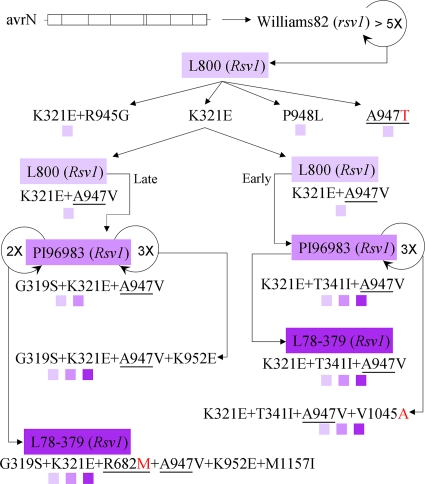FIG. 2.
Experimental adaptation of progenies derived from molecularly cloned avrN to functionally immune Rsv1 genotype soybeans via passaging. Cloned avrN was biolistically inoculated to susceptible Williams 82 (rsv1) soybean. Progenies derived from multiple passages (circular arrow) in Williams 82 (rsv1) plants established infection only in recombinant soybean L800 (Rsv1) and not in PI 96983 (Rsv1) or L78-379 (Rsv1). Mutations in HC-Pro or P3 observed in consensus sequences of viral progenies derived from each of the infected Rsv1 genotype soybeans are indicated. One virus population with the K321E mutation was passaged once more in L800 (Rsv1), and progenies from two infected plants, one exhibiting symptoms at 7 days postinoculation (dpi) (early) and the other at 14 dpi (late), were individually adapted to other Rsv1 genotype soybeans through initial multiple passages in PI 96983 (Rsv1), followed by direct inoculation to L78-379 (Rsv1). Direct role(s) of the mutation(s) in adaptation was confirmed by reconstruction of substitutions identified in viral progenies into cloned avrN followed by biolistic inoculation to Rsv1 genotype soybeans. The small color-coded squares indicate virulence of molecularly cloned avrN-derived variants containing a mutation(s) on the indicated Rsv1 genotype soybeans. Purple shading of different Rsv1 soybean genotypes is as described in the legend of Fig. 1. The positions of amino acids identified by both the functional genomic approach (Fig. 1) and experimental adaptation are underlined, and residues identical to those of virulent SMV-G7 (virG7) are shown in red (compare with Fig. 1). Note that the amino acid residue of virG7 at the position corresponding to V1045A is also alanine.

